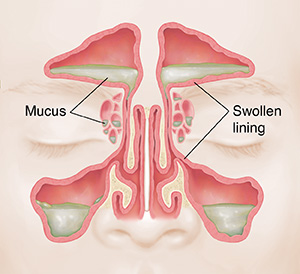Acute Bacterial Rhinosinusitis (ABRS)
Acute Bacterial Rhinosinusitis (ABRS)

Understanding your sinuses
The nasal cavity is the large air-filled space behind your nose. The sinuses are a group of spaces formed by the bones of your face. They connect with your nasal cavity. ABRS causes the tissue lining these spaces to become inflamed. Mucus may not drain normally. This leads to facial pain and other symptoms.
What causes ABRS?
ABRS most often follows an upper respiratory infection caused by a virus. Bacteria then infect the lining of your nasal cavity and sinuses. But you can also get ABRS if you have:
Nasal allergies
Long-term nasal swelling and congestion not caused by allergies
Blockage in the nose
Symptoms of ABRS
The symptoms of ABRS may be different for each person and include:
Nasal congestion or blockage
Pain or pressure in the face
Thick, colored drainage from the nose
Other symptoms may include:
Runny nose
Fluid draining from the nose down the throat (postnasal drip)
Headache
Cough
Pain
Fever
Diagnosing ABRS
ABRS may be diagnosed if you’ve had an upper respiratory infection like a cold and cough for 10 or more days without improvement or with worsening symptoms. Your healthcare provider will ask about your symptoms and your medical history. The provider will check your vital signs, including your temperature. You’ll have a physical exam. The healthcare provider will check your ears, nose, and throat. You likely won’t need any tests. If ABRS comes back, you may have a culture or other tests.
Treatment for ABRS
Treatment may include:
Antibiotic medicine. This is for symptoms that last for at least 10 to 14 days.
Nasal corticosteroid medicine. Drops or spray used in the nose can lessen swelling and congestion.
Over-the-counter pain medicine. This is to lessen sinus pain and pressure.
Nasal decongestant medicine. Spray or drops may help to lessen congestion. Do not use them for more than a few days.
Salt wash (saline irrigation). This can help to loosen mucus.
Possible complications of ABRS
ABRS may come back or become long-term (chronic). In rare cases, ABRS may cause complications such as:
Inflamed tissue around the brain and spinal cord (meningitis)
Inflamed tissue around the eyes (orbital cellulitis)
Inflamed bones around the sinuses (osteitis)
These problems may need to be treated in a hospital with intravenous (IV) antibiotic medicine or surgery.
When to call the healthcare provider
Call your healthcare provider if you have any of the following:
Symptoms that don’t get better, or get worse
Symptoms that don’t get better after 3 to 5 days on antibiotics
Trouble seeing
Swelling around your eyes
Confusion or trouble staying awake
Updated:
May 21, 2017
Reviewed By:
Holloway, Beth Greenblatt, RN, M.Ed.,Image reviewed by StayWell medical illustration team.,Kacker, Ashutosh, MD